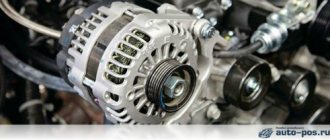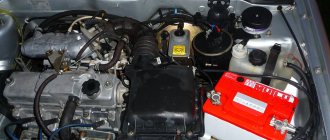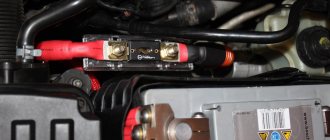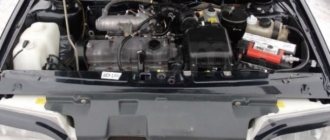If the car seizes, but the engine does not start
If it is not possible to carry out repairs at a car repair shop, then you will have to fix everything yourself. This does not require any special skills. First of all, you need to clean the contact points of the battery. Also check the car's spark plugs and clean them of dirt. Poor and dirty starter contacts can also cause engine failure. The best way to find a problem is by elimination.
The fuel supply system also plays a significant role in the operation of the vehicle. If the starter is working well, at the moment of engine failure, we check it. It consists of a carburetor, a special pump and an injector. It is best to start checking with the pump. On some cars it may be electric. When you turn on the ignition, you should hear the sound of a running motor; if you can’t hear it, then it could burn out. Also, lack of voltage can stop it from working. In this case, it is necessary to check the fuses.
On carburetor cars, on the contrary, it is necessary to check the mechanical pump. You can find out about its working condition using the hose from the outlet fitting of the pump or carburetor. Using a special handle, look at the condition. If gasoline begins to splash out of the pump, then the entire system is working properly.
On injection cars we carry out a similar procedure. The only difference is the location of the fitting. As soon as the valve is pressed, gasoline will spray out of the hose. The fuel must be under high pressure in the fuel pump. In this case, you can judge the good technical condition.
If after these procedures the engine also does not start, then it is best to go to a specialist. In auto repair shops it is necessary to carry out a complete diagnosis of the carburetor of the vehicle. It is virtually impossible to do such a procedure on your own. It is performed using special equipment. Replacement and diagnostics are quite an expensive process, so you need to choose a good workshop. Many experts note that in order to eliminate such breakdowns, it is necessary to regularly carry out an initial technical inspection of the machine.
The ECM and DPKV sensors have failed
The controller, or ECM (engine management system) sensor, is working when the light on the dashboard is on. If it doesn't light up, it doesn't work.
This is the main device on which the functioning of the remaining sensors involved in starting the engine depends. It transmits a signal to other important elements of the engine control system, and also detects technical malfunctions of these devices.
A faulty DPKV can only be replaced; if it is faulty, the engine will not start. This is indicated by the engine fault light. The malfunction is identified and eliminated after appropriate diagnostics on the appropriate equipment.
Gasoline is not supplied
Let's move on to the second group of faults: the starter turns, but the engine does not start. It’s unlikely that you didn’t notice the light on, signaling a low fuel level - and there is simply no gasoline in the tank. Most likely, there is enough gasoline, but there is a malfunction in the power system.
Therefore, let's start with the simplest diagnostics - if after turning the ignition key you do not hear a buzzing sound, then the fuel pump does not turn on. Sometimes this happens due to oxidation of the electric motor commutator after a long period of inactivity. Or there is no power supplied to it, because it is often this circuit that alarm installers cut into. Another probable reason, which occurs exclusively in winter, why fuel is not supplied to the engine, is that the water that has entered the tank has frozen and blocked the path of the “fuel”.
Problems with the fuel system
Even the most “vigorous” battery and a new, working starter will not be able to start the car if problems arise with the supply of fuel to the cylinders. For this reason, the next thing to check is the engine power supply system.
Fuel pump
For carburetor and diesel engines, this unit is located directly next to the cylinder head or block. Injection power plants are equipped with an electric pump, which is installed in the fuel tank. Their operation is judged by a short buzzing sound that appears after the ignition is turned on. As for fuel pumps in carburetor engines, they are mechanically driven by a cam mounted on the camshaft.
It is easy to check the functionality of the fuel pump - to do this, remove the hose from the carburetor inlet fitting and lower it into a suitable container. After this, you should pump up the fuel using the manual pumping lever or by turning on the starter. If the result is negative, check the passage of gasoline through the fuel line and clean the mesh located in the top cover of the pump. If this does not help, then inspect the membrane and valves of the fuel pump. After replacing damaged and worn parts, the functionality of the device will be restored.
Symptoms of a clogged fuel filter:
- significant excess fuel consumption;
- the engine does not start well;
- its power decreases - there is no traction, the car accelerates poorly (especially when driving uphill);
- sharp acceleration threatens to turn into a stalled engine;
- at idle speed there is uneven operation of the engine;
- Spontaneous braking of the car may occur without driver intervention.
Starter problems
The starter often fails in cars of any manufacture. He does not have enough strength to spin, and therefore to put the engine into operation. To solve this problem, you need to know all the vulnerabilities of this machine part. The driver needs to check the functionality. The starter on foreign cars is more demanding than on domestic cars.
To troubleshoot, it is recommended to remove it from the car and completely clean the body and fastening elements. Old grease must be carefully removed from the part. This is quite simple to do, but you shouldn’t abuse it. You can check the starter for noise level. If you hear a clicking sound when you try to ignite and it does not turn, then the reason is the relay. Therefore, here you only have to change or repair it. But it should be remembered that the relay is repaired if it is disassembled into its component parts.
The starter is acting up
The most common causes of failure: oxidized and burnt contacts, traction relay frozen due to moisture, wear of brushes and commutator. If the starter is accessible from above, you can simultaneously try to turn on the starter and tap the traction relay with a wrench or hammer (only lightly!). Or close the starter contacts directly. To do this, use a screwdriver to bridge the thick terminal to which the positive wire from the battery goes with a small terminal to which the thin wire goes. If the starter starts to rotate, the starter control circuits (usually the ignition switch) are faulty or are blocked by a faulty alarm system.
If the car has a manual transmission, you can push the engine and drive to the service under your own power. If you have an automatic, look for a tow if the service is close, or call a tow truck.
Starter and ignition switch
You can diagnose the correct operation of the ignition switch in the following way: the key in the ignition switch is turned to the second position. A failure of the ignition switch will be indicated by lights on the control panel that do not light up.
But you can use one more method to check - if the headlights that are turned on when starting the engine begin to dim, this is evidence that the ignition is working properly. If this node turns out to be faulty, the problem can be solved by replacing the switch.
The starter can be seriously damaged by dirt accumulating on it.
You can check it only if you have a tester, and for this you will definitely need a partner. So, the tester should be connected to the starter power wire. At this time, your partner should try to start the engine. If the tester readings indicate the presence of electric current in the circuit, but the starter does not crank, then in this case the starter will definitely have to be replaced.
Attention! During the procedure, try not to touch the exposed wiring with your hands - be sure to use insulating gloves!
What to do if the voltage does not reach the starter
If the headlights continue to burn brightly when you try to start the engine and nothing happens (the starter does not turn), then the voltage is not reaching the starter. This could be due to an open or poorly adjusted emergency park/neutral switch, damaged ignition switch, or faulty starter relay (solenoid). Fuses and fuses are also worth checking, as they could have burned out from overload caused by constant cranking or starting from an external source (“lighting up”).
If the starter clicks when you try to start the engine, but nothing else happens, there may not be enough current to turn the starter. Or maybe the starter has failed
The problem may be a bad battery cable, solenoid or ground, or high resistance of the solenoid itself. Check the voltage at the solenoid to see if battery voltage is passing through the ignition switch circuit. If the solenoid or relay is receiving battery voltage but is not closing its contacts or conducting enough electrical current to turn the starter motor, the solenoid ground may be damaged or the solenoid contacts may be worn, burnt, or corroded.
If the starter turns bypassing the solenoid, it means a new solenoid is needed, not a starter.
Most engines only start at 200 to 300 rpm, so if you have a weak starter that can't get the engine up to speed and provide compression, the engine won't start. In some cases, a weak starter will be able to spin the engine to the required speed, but the engine will still not start, since the starter will take all the battery charge and leave no energy for the injectors or ignition system.
Details on how to drive a manual
When, when trying to start the engine, the headlights dim and the crankshaft does not turn or turns weakly, this may be due to the fact that the starter is jammed, it is slipping or overcoming high internal resistance, its brushes are worn out, or there is a short circuit or break in the windings or armature. Measure the current draw of the starter to see if it is drawing too much current.
Why doesn't the car start if the battery is charged and the starter cranks the engine normally?
This is a slightly more complicated situation, but here, too, as a rule, you can cope on your own , although some situations require serious qualified intervention. If you find yourself in such a situation, then it’s time to remember our mastodon garage sages: either there is nothing to burn, or there is nothing to set on fire. And although the range of problems here is somewhat wider than in the first case, the search still comes down to exactly this.
Before moving on to the table, let's go over some key points. So, if you find yourself in this situation, don't try :
- turn the starter “until victory” , so as not to aggravate the problems that are already evident. If the car does not start after two or three five-second attempts, you should not hope that the fourth or fifth will help. And even more so, you don’t need to “push” the starter for 20-30 seconds - this way you can not only drain the battery, but also burn out the starter;
- Trying to repair something you don’t understand can also result in additional problems. If you are not confident in your abilities, try calling someone you trust to help you.
In order to get out of this situation with dignity, it is advisable to learn how to check whether the spark plugs give a spark and have with you the necessary tool for replacing the spark plugs, suitable specifically for your car. In addition, it would be nice to learn how to measure fuel pressure in the line , but this is a more complicated procedure. A universal multimeter or at least a simple indicator made from a piece of wire and a light bulb will not be superfluous.
Finally, it’s a good idea to get a universal diagnostic tool that allows you to read information from the OBDII connector and via the Bluetooth wireless protocol to any smartphone with the application installed.
| Symptom | Possible reasons | Elimination |
| The starter cranks the engine, but it does not start, there are no sparks in the cylinders or they are very weak. There is a spark and the engine sounds normal when cranking. | – No fuel. You will laugh, but this is a common reason for such “failures”. Sometimes the cause may be a faulty or incorrectly installed fuel level sensor. – Faulty fuel pump or its circuit , faulty alarm relay that interrupts the fuel pump circuit, faulty fuel pump relay or blown fuse – The fine filters of the fuel pump or the fine filter are clogged; gasoline is supplied to the injectors in insufficient quantities or under insufficient pressure. — Malfunction in the electronic engine control system (most often, the mass air flow sensor has failed) – Too weak a spark , “wet” or soot-filled electrodes on the spark plugs, cracked high-voltage wires. – The valve timing is disturbed (“the timing belt has jumped”) | – Add fuel. If the fuel level sensor shows that there is still fuel, but in fact the tank is empty, replace or repair the sensor. – In this case, when you turn on the ignition, there is no characteristic buzzing from the rear (if the gas pump is installed in the gas tank) or front (if the pump is located in the engine compartment) parts of the car. Check the electrical circuits and functionality of the fuel pump motor; if necessary, replace the entire pump or its motor. – This also happens on injection engines - if there is half a tank of fuel or more, the car starts and drives, if there is less, it doesn’t. Sometimes the problem can be temporarily solved by tapping the gas tank with a suitable stick; sometimes (especially in winter on diesel engines) it is necessary to replace the fuel filter and clean the fuel pump screens. – If you suspect a mass air flow sensor , but do not have the means to independently diagnose the ECM, try removing the chip from it - the car should start, although it may run unevenly, with increased flow, etc. The same recipe works with the coolant temperature sensor. – Problems with sparking can be insidious : “in air” the spark seems to “jump” between the electrodes, but in the cylinder it can no longer “break through” compression. In this case, the problem is most often in spark plugs or high-voltage wires. The easiest way is to replace the spark plugs, and if that doesn’t help, then the wires, but there are also camp repair methods. Spark plugs can be cleaned of carbon deposits and ignited on the flame of a gas burner or lighter, and cracked and sparking high-voltage wires can be poured generously with WD-40 or a similar liquid. – A “jumped” timing belt does not occur very often, and most often it is preceded by some out of the ordinary incident - a strong blow when the car falls into a hole, a gear that is mixed up at speed, etc. Diagnosing this malfunction is quite complicated - you need to disassemble the belt casing, count the teeth relative to the marks, and, if the diagnosis is confirmed, change the belt. |
| The starter cranks the engine, but it does not start, there is no spark in the cylinders. It will spark, the engine sound is normal when cranking. | – Malfunction in the electronic system engine control (breakage or “non-contact” of the crankshaft position sensor, “brains”, fuse) – Malfunction in the ignition system | – Check the ECM fuse, try to diagnose the entire system or measure the voltage at the ECM and DPKV – Often such symptoms indicate a failure of the ignition module , especially if there is only one for all four cylinders (such a scheme is increasingly found on cars). In archaic designs, such symptoms can occur when the switch, ignition coil fails, the central high-voltage wire breaks, or the distributor “coal” wears out. |
| The starter cranks the engine, but it does not start; the engine cranks with characteristic popping noises and at a higher frequency than usual. | – There is no compression in the engine cylinders . The timing belt has broken, the valves have broken or burned out, or the piston has burned out. | – This also happens - a car, losing traction , “with all its might” reaches the parking lot, and when you try to start the engine again, nothing happens. In case of such serious malfunctions, only engine repair will help. |
Battery low
This can happen in one frosty night if you forgot to turn off some consumer of electricity (for example, headlights), and the car does not have battery discharge protection. This happens even more often with cars that have non-standard powerful “music” or security alarms installed. Nowadays, many people work remotely and don’t go anywhere for weeks - during this time, the old battery can run out, even if there is no increased energy consumption.
Place the dead battery on charge. And if you need to go urgently, you can “light up” from the donor car (don’t forget to put jumper wires in the trunk in advance) or from a battery starting device (booster). If the car has a manual transmission, you can revive the engine by towing it or pushing it.
Circuit breakers
The reason that the engine does not start when the starter is working properly may be as follows: there is no electricity supplied to the spark plugs. By the way, they themselves cannot in any way serve as the cause of problems, if only because the likelihood of them all failing, and even at the same time, is small. Therefore, it may very well be that voltage is simply not supplied to the high-voltage wires connected to them. If the design of the ignition system of a particular engine is such that it is supplied through fuses, then first of all you need to check them.
Electronic engine control unit
All modern engines installed in passenger cars are equipped with electronic control units, which may also be the reason why, with a charged battery and a working starter, as well as a working ignition system, the engine may not start at all, or, once started, it stalls immediately.
This can happen, for example, when the ECM or DPKV sensors fail. The bottom line is that after starting the engine, they send its electronic control unit incorrect data about the composition of the fuel mixture and the position of the crankshaft. The ECU interprets them and issues completely different commands to the corresponding actuators. As a result, the engine, as soon as it starts, immediately stalls.
Another “electronic” reason that it is impossible to start the engine when the battery is full of energy and the starter is full of power is a malfunction in the car alarm. Almost all passenger cars are now equipped with it, and not all models of these devices are highly reliable. Quite often it happens that they are the ones who block the engine from starting, believing that they are trying to start it in an “unauthorized” way.
Throttle valve
As for possible malfunctions of the fuel system leading to the inability to start the engine, among them, as practice shows, problems with throttle valves lead by a wide margin. These design elements of modern internal combustion engines are nothing more than mechanical regulators of the flow area of the channel through which the fuel mixture ultimately enters the cylinders.
If the throttle valve does not work correctly for one reason or another, then it simply, in fact, cuts off the fuel supply. Since the cylinders are empty and there is nothing there to ignite, the engine does not start.
This can be fixed like this:
- Use a charger to start.
- Use a portable AC voltage rectifier.
- Take the discharged battery to a service station.
- “Light a cigarette” from the battery of a compassionate neighbor.
- Use a taxi, but warn that you need to recharge the battery.
If there were no prerequisites at all and suddenly the car does not start, inspect its electrical system. Maybe some wire came loose and a short circuit occurred.
If you need to go very urgently, ask a passerby to push the car. While sitting behind the wheel and engaging 2nd gear, press the clutch and do not release it, and as soon as the car accelerates to 20 km/h, release it. Of course, this won’t happen with automation. If there is no one nearby, push yourself, steering, and jump inside at the right moment and immediately engage 2nd gear. Let the car run at medium speed for ten minutes.
Spark plug
The problem with starting the engine may be related to the spark plugs. Their performance is checked as follows: the spark plug is unscrewed, then connected to the high-voltage wiring and placed on one of the metal parts. At this time, the assistant turns the ignition key. The absence of a spark will indicate a faulty spark plug.
Attention! Before checking the spark plug, you should make sure that there are no flammable liquids near the test site. Do not touch the spark plug with your hands while turning the ignition key. The presence of a spark is determined only visually.
If it is not possible to reach the spark plugs, you can use an inductive tool to check them. When the magnetic field is detected by it, the indicator will light up - this will mean that the candle is fully operational. Otherwise, this component will have to be replaced.
There may be several reasons why a spark does not appear during diagnostics:
- the ignition module is faulty;
- the ignition coil is broken;
- The shaft position sensor is faulty.
To check the above sensors, electronic diagnostics are used by connecting the scanner to a special connector. It reads errors that occur when sensors are damaged. You can also use an ordinary voltmeter for this purpose. The resistance shown by it must comply with the standards established by the manufacturer, otherwise we can confidently assume the possibility of a sensor malfunction.
The spark is gone
Car starting process
To narrow down the reasons why the engine does not start, consider the process of starting a car. You need to better understand what happens when you turn the ignition key.
What happens on a properly running car?:
- You sit behind the wheel and insert the ignition key into the ignition.
- Turn the key to the first position - turn on the ignition, the lights on the instrument panel light up, and an internal test occurs.
- Turn the key further and the electric starter starts working, which in turn spins up the engine. It's easy to hear by ear.
- The next moment you hear that the engine has started, you must release the key, which will return to its original position. The engine is running and you are ready to start driving.
A number of things can go wrong during the engine starting process and we need to help you identify where the problem is in order to determine what needs to be done to resolve the situation.
timing belt
Both a belt and a metal chain can be used as a timing drive. This mechanism is responsible for the rotation of the crankshaft and camshaft. After a certain time, the drive will definitely wear out - this applies to a greater extent to the belt drive, which may even break. Because of this, the valves become deformed, which is already a serious breakdown of the propulsion system and, of course, if such damage occurs, the car will not be able to start. To avoid this, it is necessary to replace the belt drive at least once after 60,000 km.
Belt broke
There are much fewer mechanical faults that prevent the engine from starting than electrical ones. The most likely is a broken timing belt. Due to increased loads when cranking a frozen engine, a worn drive most often breaks during startup. It happens that the crown on the flywheel turns. In this case, the starter cannot spin the engine to starting speed.
***
In general, modern cars are reliable. And most often the engine does not start because the battery is discharged or the contacts of the power wires have oxidized. But the above malfunctions are also not exotic. And when they arise, it is better to have at least a rough idea of what is wrong with the car. Then it will be easier to negotiate with the servicemen.
The key does not fit into the ignition switch
Yes, the very first, simplest and most banal problem. This can happen for several reasons: the most obvious is that you are using the key for the wrong car or your key is already worn out . If you have spare keys, try them.
Very often, the problem can occur when you try to turn the key to turn on the ignition, but it does not turn due to the steering wheel being locked . To fix this, you need to turn the steering wheel first in one direction, then in the other, while trying to turn the key. This should relieve pressure on the steering column, unlock it and allow you to turn the key and turn on the ignition.
Also, in modern cars, a chip is built into the key that protects the car from theft and it can fail. Try another key from the kit.
Air filter
To start the engine properly, you need a lot of clean air. Its flow will be greatly hampered if the air filter is clogged. As a result, this leads to difficulty starting the engine due to the incorrect air mixture required to ignite the fuel. You need to check not only the filter itself, but also the air ducts - debris can also accumulate in them.
Filter connections can also leak.
For example, the engine may not start due to too much oxygen entering the system, which may well be caused by damage to the pipes.
By the way, visual inspection of pipes does not always give positive results - checking their tightness is much more effective by ear.
Low air temperature
If the air temperature drops to 15 degrees, then any battery loses up to 50% of its power. At the same time, it can be very difficult to start the car. To “wake up” the car, you should activate the high beams for a few minutes. As a result, the electrolyte will heat up, which will give it additional energy.
When trying to start the engine, do not turn the starter for more than 5 seconds, as in this case you can fill the spark plugs or completely discharge the battery. Do not forget that trying to start the engine in severe frost will be equivalent to driving 500 km.
Why doesn't my car start in winter?
The car and all its systems experience increased loads in winter:
- The battery is usually the first to suffer (quick discharge in the cold, the battery does not hold a charge);
- the load on the starter and generator increases noticeably, causing breakdowns;
- in conditions of high humidity, the car does not start due to oxidation of the contacts or as a result of water entering the engine compartment;
- when “cold”, worn out engines lose a lot of compression;
- in some cases, a significant change in the properties of the engine oil occurs (the lubricant becomes very thick);
For example, if the engine oil has thickened, it is more difficult for the starter to crank the crankshaft in such a viscous mass. Add to this the battery discharge, general engine wear and compression reduction, as well as not the best spark plugs and fuel. The result is that the engine starts normally in the summer, but completely refuses to start when cold weather arrives.
To avoid such problems or minimize them, it is better to fill in engine oil with “winter” viscosity (0W, 5W) in advance. It is also recommended to change all filters, change spark plugs and BB wires. As for the battery, you need to remove the battery, service and charge the battery with a charging external charger.
Problems starting a diesel engine
Starting problems occur in cars with both gasoline and diesel engines. At the same time, the diesel engine requires increased attention. Below we will consider what to do if the car does not start, but the engine itself is diesel.
When a diesel car does not start, not all car enthusiasts know what to do in this case. In diesel engines in winter:
- Diesel fuel often freezes;
- glow plugs fail;
- A well-charged battery is required;
The diesel fuel is frozen
In fact, diesel fuel freezes due to the “waxing” of such fuel in the cold.
If the starter turns, but the diesel engine does not start, you need to take the car to a warm box. In the event that the performance of the fuel system is impaired as a result of frozen fuel, the problem will be solved.
In cold weather, you should always use special winter diesel fuel (contains additives in diesel fuel that prevent the fuel from freezing).
Glow plugs
Glow plugs are also the reason why a diesel engine does not start in winter. Unlike gasoline engines, diesel glow plugs heat the combustion chamber before starting the engine so that the fuel is effectively ignited by compression.
We also recommend reading the article on how to flush the power system of a diesel engine. From this article you will learn about methods for flushing the fuel system of a diesel engine, as well as the subtleties and nuances that need to be taken into account when such flushing.
If such spark plugs do not work on a diesel engine, ignition does not occur. Glow plugs require regular inspection and replacement. At the same time, it is better to change them before the onset of cold weather; it is optimal to replace them as a set (all glow plugs are immediately replaced with new ones).
Typical problems
First, evaluate the readings on the instruments, in particular, look at the level of the filled fuel - perhaps you just didn’t notice that the gasoline in the tank is running low. But here you need to know exactly the error in the readings of your car’s sensor and be sure that it is in full working order. If this is really the problem, then take a large bottle or canister and go to a gas station near you to buy at least 2 liters of fuel there.
The next method , which will allow you to travel at least several kilometers by car, is this. A certain amount of water or other liquid is collected into a whole cellophane bag, then the bag is tightly tied with several knots so that water or liquid does not leak out of it. Tie it with a thin rope of good strength. Without rushing or fussing, place the bag into the fuel tank, gradually pushing it through the neck of the tank, do not let go of the rope.
When the bag reaches the bottom of the tank, the level of gasoline in the fuel tank will become higher, the gasoline pump will now pump it. Having reached the gas station by car, slowly remove the bag from the tank by carefully pulling it through the neck of the tank using a string.
In order to understand the real reason why the car suddenly stopped starting, look at the car's instrument panel. When the lights barely light up, and when you turn the ignition they go out completely, this indicates an almost completely discharged battery. You need to charge it to drive the car further.
This is done using the following methods:
- by using a device that has a built-in battery;
- using a 12 V converter that operates from the mains;
- take it to a nearby service station;
- “light” it from any other car. Here you need wires for lighting with special clamps.
You can call a taxi, having previously announced the purpose of the call to the dispatcher.
When the car does not start for no obvious reason, look at the car's electrical system - one of the wires could fall off the terminal and create a short circuit with a large load on the battery.
When the vehicle does not work due to a failed battery, but you need to drive quickly, use the old method of starting the car by pushing . When the car is on an uneven road or parked in front of a hill, the help of one or two people is needed. Their goal will be to push the car from behind. You sit behind the wheel, hold the clutch with the second gear engaged - when the car is moving at a speed of about 20 km/h, just take your foot off the pedal. This method is not suitable for cars with automatic transmission. Similar towing is not suitable for a car with automatic transmission.
If you are pushing the car yourself, then rest against the windshield pillar, if necessary, steer - having reached the desired speed, jump into the car, turn on second speed. Let the car run for five to ten minutes to recharge the battery.
Computer diagnostics
If a motor with a working starter does not start, pay attention to the dashboard indicators. When you turn the ignition key, the CHECK, battery, and oil pressure sensor malfunction indicators should light up, and the immobilizer indication should stop. In cars with an injector, after turning the key, you should hear the characteristic sound of the fuel pump pumping - a soft buzzing sound.
If the car does not start with the starter working normally and the tachometer needle does not move, although the electric motor cranks the engine, you need to check the crankshaft sensor. If this element fails, the engine will not be able to start, since permission to do so is not given by the electronic control unit.
To obtain complete information, diagnostic equipment is connected through a special connector, in which the car model and engine type are selected. After connecting to the car’s ECU, the laptop screen will display error codes that are currently relevant. If necessary, you can open a diagram of the car where the area with the breakdown will be localized.
When the starter is working properly, it is necessary to remove several parameters, the failure of which can lead to breakdown:
- The vacuum gauge should show a pressure equal to atmospheric pressure, about 1 bar.
- The specified idle speed must correspond to the characteristics of the engine.
- The engine temperature during cold start should be equal to the ambient temperature.
To track the operating mode of the motor, it is necessary to track its revolutions in real time when the starter rotates, for which there is a special tab in the software. To do this, the starter is started and the crankshaft speed per minute that it provides appears on the screen. The norm is a little more than 200 rpm. If the data remains at zero, the problem is in the crankshaft sensor, which needs to be replaced.
Low battery
A battery, even a brand new one, can discharge for various reasons. These are malfunctions in the operation of the vehicle’s electrical equipment or undercharging of the battery due to the connection of various additional electrical consumers.
If the battery does not charge while the engine is running, then you need to urgently go to an electrician so that a specialist can fix the problem. But also very often, undercharging of the battery (with normally operating electrical equipment) occurs due to the fault of the driver himself.
Remember how you start your car in the morning. They arrived, started it, and immediately turned on the heated windows (rear and front). Fully heated seats. Heated mirrors (if equipped). Music (amplifier + sub) and a stove to warm up the interior. We connected (DVR, radar detector, phone charger, etc.) to the cigarette lighter socket. The low beams were turned on. Isn't that what happens to you?
All these consumers need to be powered by electricity that comes from the generator. The generator is not dimensionless; it is designed for a certain number of electrical consumers. And the more consumers are turned on, the less charging goes to the battery. The battery gave up some of its charge to start the engine, and now it needs to be charged again.
But the large number of electricity consumers in the car and low engine speeds do not provide enough charge for the battery. It takes time for the battery to charge again.
But you get out onto the road and again get stuck in a traffic jam (low engine speed). With such car operation, home - work, work - home, many car enthusiasts have a chronically undercharged battery. And one cold morning the car won't start.
What to do? If you drive with various electrical consumers constantly turned on in winter, then before leaving the car in the parking lot, turn off all consumers and let the engine run for at least a few minutes to charge the battery. This can be done when approaching the house (turn off the stove, heating, music). When parking the car, make sure that you have turned everything off. If you have an alarm with auto start, then check that the heating, music, and stove are turned off.
These Common Reasons Your Engine Won't Start Will Surprise You
There's nothing worse in the morning than when your car refuses to start. Here are possible reasons for this and tips for determining the cause of the problem, as well as ways to solve it.
There is no fuel in the car
This is the most common problem faced by millions of car enthusiasts. The fuel level is the first thing you should check, no matter how funny it may sound. After all, you may well not have noticed that the car’s fuel level is at zero. Yes, it may look stupid, but believe me, very often this is the reason the engine fails to start. So if this happens to you, go to the gas station. Here is a simple solution to the problem.
The clamps of the high-voltage wires are loose
The second most common reason for the engine not starting is poor contacts of high-voltage wires with the battery terminals. This occurs due to the fact that the clamps of the high-voltage wires have become loose. So if your car won't start, open the hood and check the tightness of the terminals and their condition. If there is oxidation on them, clean the terminals and then try turning the ignition on again. By the way, the first sign that the terminals have poor contact due to poor tightening is oxidation on them.
Sources
- https://AvtoSotka.ru/tyuning-i-remont/starter-ne-zavodit-mashinu.html
- https://www.zr.ru/content/articles/926421-pochemu-motor-ne-zavoditsya.-sem/
- https://topgears.com.ua/stati/sovetyi/pochemu-ne-zavoditsya-mashina-prichinyi
- https://fastmb.ru/soveti_auto/2919-pochemu-ne-zavoditsya-avtomobil-glavnye-prichiny.html
- https://AvtoNov.com/%D0%BF%D0%BE%D1%87%D0%B5%D0%BC%D1%83-%D0%BD%D0%B5-%D0%B7%D0%B0 %D0%B2%D0%BE%D0%B4%D0%B8%D1%82%D1%81%D1%8F-%D0%BC%D0%B0%D1%88%D0%B8%D0%BD% D0%B0/
- https://KrutiMotor.ru/ne-zavoditsya-mashina-prichiny/
- https://topmekhanik.ru/chto-delat-esli-ne-zapuskaetsya-motor/
- https://1gai.ru/publ/522183-15-prichin-po-kotorym-vash-avtomobil-ne-zavoditsya.html











